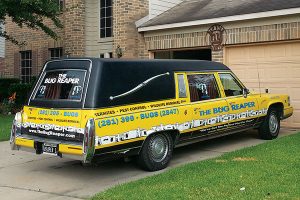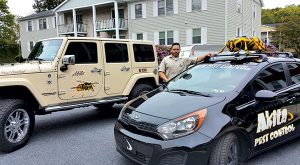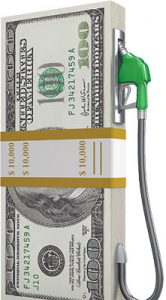PMPs put the profit pedal to the metal thanks to favorable fuel prices, tricked-out vehicles and routing tools.
What a difference eight years makes. In July 2008, regular gas prices spiked to a wallet-emptying $4.50 per gallon (U.S. average). This year, pest management professionals (PMPs) have welcomed a new low: gas prices fluctuating between $1.75 and $2.25 per gallon — something not seen since the early 2000s.
In addition to lowering one’s blood pressure, the drastic drop in gas prices has enabled PMPs to invest more in new vehicles, fleet maintenance, catchy branding and time- and money-saving routing tools.
“If we were able to get by on the budget we used during the gas crisis, we can certainly keep spending that same amount now, reinvesting fuel savings elsewhere to grow the business,” says Bobby Leon, owner of Akita Pest Control, Lancaster, Pa.
Fuel for thought
Some PMPs roll today’s gas savings into their general budgets. They reinvest in their fleets and other areas — in equipment, products and people.
Mickey Ferrell Jr., a marketing consultant for HomePro Pest Control in Chesapeake, Va., says money saved at the pump has funded investments such as new mosquito misters and an increased advertising presence.
Some take their extra gas money and invest it mostly (or solely) in their fleets.
“Recently, we’ve had to add more than 20 vehicles per year, due to growth,” says Keith Duncan Jr., CEO of Jeffersonville, Ind.-based Black Diamond Pest Control. “But our money saved on gas has alleviated many of our potential financial growing pains.”
Fleet upgrades
HomePro’s Ferrell says regular tune-ups can help PMPs keep trucks on the road and save money in the long haul.
Who should manage the vehicle maintenance?
Ferrell says so much is riding on it that PMPs must ensure the people assigned the task have the training and time to properly manage the fleet. He warns PMPs against assuming all technicians can add this to their workloads.
Black Diamond’s Duncan says many technicians are well equipped to help monitor vehicle maintenance. The company’s technicians report mileage weekly, helping ensure vehicles are serviced at appropriate intervals. Black Diamond employs a team of ace mechanics to take it from there.
Another component of fleet management is maintaining vehicle aesthetics.
“I don’t want any dirty vehicles on the road — unless it’s raining that day,” Akita’s Leon says. “But even then, by the next day, I want that vehicle spotless because it’s a reflection of our company.”
Rolling billboards
For decades, PMPs have adorned their vehicles with company names and phone numbers. Nowadays, more are grabbing eyeballs with flashy fleets of tricked-out trucks.
From its stretch Volkswagen Beetle “Mouselimos,” outfitted with mouse ears and gull-wing doors, to its “Antique Fleet” — which includes a 1923 Dodge Roadster, 1924 Maxwell and 1929 Nash Cabriolet — Truly Nolen is pest management’s granddaddy of the rolling billboard. Truly Nolen’s eye-catching roadsters truly captivate and educate.
If a mouse-ified VW isn’t in the cards, don’t fret. There are plenty of other routes to bold-branding through vehicles. For instance, every day is Halloween for The Bug Reaper, based in Houston.
“Not a day goes by that people don’t stop me to take a picture of our company hearse and tell me how cool it is,” says Tony Esposito, owner of The Bug Reaper.

The Bug Reaper knows how to strike fear in the heart of pests: by rolling up to the job in a hearse.
Photo: The Bug Reaper
“We even carry a casket as our toolbox,” Expositio adds. “When folks see the casket, they lose it!”
Esposito bought the vehicle used.
“The hearse is inexpensive to maintain, comfortable to ride in, and came with low mileage … all at low speeds,” Esposito adds.
Akita Pest Control has gone another direction — a bit higher than 6 ft. under — with its fleet branding. Mounted atop Akita’s vehicles are giant, 3D yellow jacket wasps. The sculptures look like something straight from a ’50s sci-fi movie.
“People constantly take pictures of our company vehicles,” Akita’s Leon says. “We’ve even caught PMPs from other pest management companies with cameras in hand.”

When is a bug like a mouse? When it’s a Truly Nolen signature customized Volkswagen.
Photo: Truly Nolen
Beware: The giant 3D wasp was responsible for an Akita tech being pulled over.
“The police just wanted to get a closer look, ask questions and offer a compliment,” Leon chuckles.
Route to rising revenue
More companies are using fuel savings to upgrade their vehicles with global positioning system (GPS) technology. Many say GPS — especially when combined with routing software from providers like ServicePro and WorkWave — helps PMPs add two to three stops per day per tech. That’s a quick route to rising revenue.
“GPS technology empowers pest management companies to increase driver accountability, and reduce fuel, maintenance and labor costs,” says Ryan Driscoll, marketing director for GPS Insight, based in Scottsdale, Ariz. “Reducing idling, speeding and unnecessary miles means even more savings for PMPs.”
Bill Wert, owner of an Orkin franchise in Tallahassee, Fla., says Fleetmatics’ GPS technology has simplified and optimized his company’s fleet management. If his company fields a call asking for fast service, a dispatcher can look at a screen in the office and see which vehicles are in closest proximity to that account.
“With GPS technology, our technicians can come to the aid of clients who need immediate service much faster,” Wert says. “And when it comes to regular routing and scheduling, you can’t beat it.”
Wert’s company also leverages GPS technology to rate — and encourage — driver safety (not speeding or tailgating, for example) and lower related insurance costs.
“Not only are we reaping significant savings by leveraging GPS and routing technology, we’re also paying just two-thirds what we used to at the pump,” Wert adds.
That’s a wrap
HomePro Pest Control in Chesapeake, Va., is just one of many firms investing in vinyl graphic vehicle wraps. Applied directly over the original paint, the makeovers are instant and compelling, says Mickey Ferrell Jr., a marketing consultant for HomePro.
“At first, cost was a sticking point,” Ferrell says. “I knew the wraps would have a positive effect on business, but wasn’t sure each was worth $2,300. It didn’t take long to see a return on our investment.”
Sweetening the deal, vehicle wraps can attract new business in already-served areas, improving routing efficiency and profitability.
Nearly 20 years ago, Black Diamond was among the first in its service area to have its vehicles professionally lettered. Black Diamond kicked it up a notch after CEO Duncan stumbled upon a vehicle wrap vendor at a local custom car show. Duncan and his team came up with a spider web wrap design that snares second looks — and new business.
“Now we have lettered and wrapped vehicles,” Duncan says. “Both get recognized, but the custom spider-web wraps turn more heads and start more conversations.”
HomePro’s Ferrell likens the company’s investment in vehicle wraps to providing professional uniforms for technicians.
Click to enlarge.
- Assassin Pest Control
- Payback Pest Control’s purple-and-white vehicle wrap has definite eye-catching curb appeal.
- Brian Hirsch, director of sales for Protect-A-Bed’s industrial division, stands outside one of the company’s easy-to-spot distribution trucks.
- HomePro Pest Control in Chesapeake, Va., is just one of many firms investing in vinyl graphic vehicle wraps.
- Bio-Chem’s sales manager, Arizona Jones, stands with an example of Bio-Chem’s detailed graphic wraps.
- Truly Nolen’s eye-catching roadsters truly captivate and educate.
- Bugtime’s Pest Control Products & Service keeps its rolling message simple, sweet and effective.
- Even when it’s not menacing the public from atop a vehicle, Akita’s well-known wasp makes itself known in some way on most of the company’s vehicles.
- Smith Pest Control’s buggy pickup truck.
Photos: HomePro Pest Control, Bio-Chem Exterminating, Assassin Pest Control, Truly Nolen, Smith Pest Control, Bugtime Pest Control Products & Service, Payback Pest Control, Protect-A-Bed, Akita Pest Control
Fuel for thought
Here are 10 easy-to-adhere-to tips for getting the most from your fleet’s fuel consumption.
-
Weight-conscious — Take an inventory of what your vehicles are carrying to get a gauge of what’s unnecessary. Non-essential extras that do little more than take up space can be a drag on your fuel efficiency. Likewise, stow inside your vehicle any bulky tools currently occupying your roof rack, if they fit. The less aerodynamic the vehicle, the more gas you’re burning in transit.
- Not ideal to idle — Don’t let your vehicle idle for more than a minute. You burn more fuel during 60 seconds of idling than you do when you turn off the engine and restart it.
- Fine-tuning — It’s no surprise that regular tune-ups extend a vehicle’s life. But all vehicles are different. Check your vehicles’ owner manuals to see the manufacturer-suggested tune-up schedule specific to what you’re putting on the road. Simple oil changes, air filter changes and spark plug replacements mean more than a longer life for your fleet vehicles: Tune-ups increase fuel efficiency and minimize emissions.
- Cruisin’ — Do your vehicles have cruise control functionality? If so, employ it when driving longer distances to increase miles-per-gallon efficiency. When used correctly, cruise control also minimizes rapid acceleration, which — in addition to abrupt stops — lowers fuel consumption.
- Playing it cool — When possible, park in the shade to minimize the evaporation of fuel on hot days.
- No need for speed — Busy days with a full roster of accounts to service can make for lead-footed drivers, regardless of whether they realize they’re speeding. But keeping a moderate pace saves money. Pedal-to-the-metal starts at green lights and higher-speed driving increase fuel use.
- Kicking the tires — Properly inflated tires can have a significantly positive impact on fuel consumption. Also, investing in low rolling resistance (LLR) tires helps diminish drag.
- Re-assess routing — Are your planned routes as efficient as they could be? Are you sure about that? The more time you take planning each vehicle’s route, the more likely you are to hit as many accounts as possible before tanking up again. But don’t be a slave to your routes. GPS and radio traffic reports can help you avoid jams and congestion caused by road construction or accidents.
- Paying at the pump — Keep a few things in mind while gassing up at the station: First, choose the right octane for your vehicle based on its owner’s manual. Additionally, don’t top off your tank when filling it. Finally, check your gas caps and make sure they’re tightly sealing, not damaged. A loose gas cap means faster fuel evaporation.
- A critical look — Think about the vehicles you own. Can you build a more fuel-efficient fleet? Ask yourself whether your vehicles are the right size for the job, and downsize if they are too large. Consider replacing any vehicle that is frequently out of service because of mechanical problems. Choose a lighter vehicle with a smaller engine to conserve fuel.
More online
The tips here were compiled from a variety of sources, but primarily from the Transportation Research Board: TRB.org
Senior Editor Will Nepper can be reached at wnepper@northcoastmedia.net or 216-706-3775.















Leave A Comment